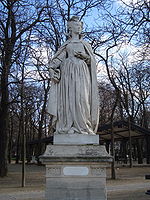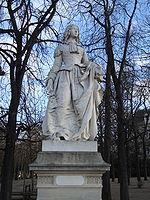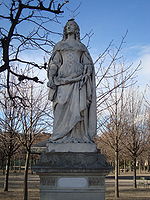
Emmanuel Frémiet was a French sculptor. He is famous for his 1874 sculpture of Joan of Arc in Paris and the monument to Ferdinand de Lesseps in Suez. The noted sculptor Pierre-Nicolas Tourgueneff was one of many students who learned sculpture under the tutelage of Frémiet.

The Jardin du Luxembourg, known in English as the Luxembourg Garden, colloquially referred to as the Jardin du Sénat, is located in the 6th arrondissement of Paris, France. The creation of the garden began in 1612 when Marie de' Medici, the widow of King Henry IV, constructed the Luxembourg Palace as her new residence. The garden today is owned by the French Senate, which meets in the palace. It covers 23 hectares and is known for its lawns, tree-lined promenades, tennis courts, flowerbeds, model sailboats on its octagonal Grand Bassin, as well as picturesque Medici Fountain, built in 1620. The name Luxembourg comes from the Latin Mons Lucotitius, the name of the hill where the garden is located, and locally the garden is informally called "le Luco".

The Salon, or rarely Paris Salon, beginning in 1667 was the official art exhibition of the Académie des Beaux-Arts in Paris. Between 1748 and 1890 it was arguably the greatest annual or biennial art event in the Western world. At the 1761 Salon, thirty-three painters, nine sculptors, and eleven engravers contributed. From 1881 onward, it was managed by the Société des Artistes Français.

Aimé-Jules Dalou was a 19th-century French sculptor, admired for his perceptiveness, execution, and unpretentious realism.
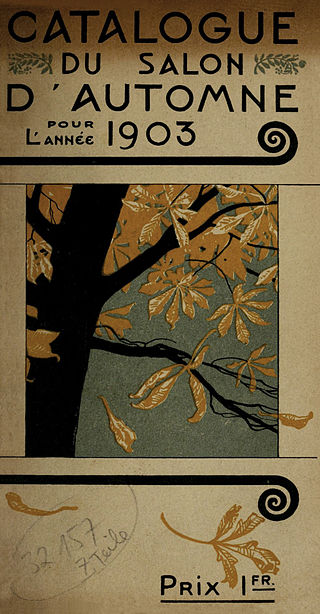
The Salon d'Automne, or Société du Salon d'automne, is an art exhibition held annually in Paris. Since 2011, it is held on the Champs-Élysées, between the Grand Palais and the Petit Palais, in mid-October. The first Salon d'Automne was created in 1903 by Frantz Jourdain, with Hector Guimard, George Desvallières, Eugène Carrière, Félix Vallotton, Édouard Vuillard, Eugène Chigot and Maison Jansen.

Aimé Nicolas Morot was a French academic painter and sculptor.

Jean-Baptiste Auguste Clésinger was a 19th-century French sculptor and painter.

The Fontaine de l'Observatoire is a monumental fountain located in the Jardin Marco Polo, south of the Jardin du Luxembourg in the 6th arrondissement of Paris, with sculpture by Jean-Baptiste Carpeaux. It was dedicated in 1874. It is also known as the Fontaine des Quatre-Parties-du-Monde, for the four parts of the world embodied by its female figures, or simply the Fontaine Carpeaux.

Jacques-Édouard Gatteaux was a French sculptor and medal engraver. Born in Paris, he studied under his father Nicolas-Marie Gatteaux and Jean-Guillaume Moitte.
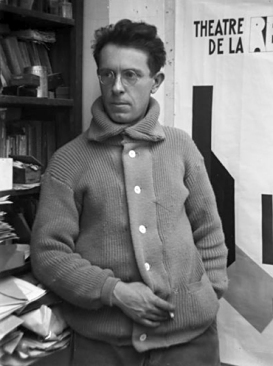
Joseph Csaky was a Hungarian avant-garde artist, sculptor, and graphic artist, best known for his early participation in the Cubist movement as a sculptor. Csaky was one of the first sculptors in Paris to apply the principles of pictorial Cubism to his art. A pioneer of modern sculpture, Csaky is among the most important sculptors of the early 20th century. He was an active member of the Section d'Or group between 1911 and 1914, and closely associated with Crystal Cubism, Purism, De Stijl, Abstract art, and Art Deco throughout the 1920s and 1930s.

Henri Clément Serveau, also known as Clément-Serveau, was a French painter, designer, engraver and illustrator. Clément-Serveau produced works in a realist manner early on, but soon became interested in the new movements. He was influenced by his friend Louis Marcoussis and experimented with Cubism, utilising geometric patterns to give the illusion of form and space. Later in his career, he turned toward abstraction with a post-cubist stance. He designed banknotes for the Banque de France, produced large murals and participated in numerous French and international exhibitions.
Jean Pierre Victor Huguenin was a French sculptor.

Groupe de femmes, also called Groupe de trois femmes, or Groupe de trois personnages, is an early Cubist sculpture created circa 1911 by the Hungarian avant-garde, sculptor, and graphic artist Joseph Csaky (1888–1971). This sculpture formerly known from a black and white photograph had been erroneously entitled Deux Femmes , as the image captured on an angle showed only two figures. An additional photograph found in the Csaky family archives shows a frontal view of the work, revealing three figures rather than two. Csaky's sculpture was exhibited at the 1912 Salon d'Automne, and the 1913 Salon des Indépendants, Paris. A photograph taken of Salle XI in sitiu at the 1912 Salon d'Automne and published in L'Illustration, 12 October 1912, p. 47, shows Groupe de femmes exhibited alongside the works of Jean Metzinger, František Kupka, Francis Picabia, Amedeo Modigliani and Henri Le Fauconnier.

Danseuse, also known as Femme à l'éventail, or Femme à la cruche, is an early Cubist, Proto-Art Deco sculpture created in 1912 by the Hungarian avant-garde sculptor Joseph Csaky (1888–1971). This black and white photograph from the Csaky family archives shows a frontal view of the original 1912 plaster. Danseuse was exhibited in Paris at the 1912 Salon d'Automne, an exhibition that provoked a succès de scandale and resulted in a xenophobic and anti-modernist quarrel in the French National Assembly. The sculpture was then exhibited at the 1914 Salon des Indépendants entitled Femme à l'éventail ; and at Galerie Moos, Geneva, 1920, entitled Femme à la cruche.

Jeanne-Henriette Tirman was a French woman painter and printmaker.

Jean-Baptiste-Antoine Guillemet was a French renowned landscape painter and longtime Jury member of the Salon des Artistes Francais. He was one of the first 19th-century artists to paint modern life, and a pivotal figure in the transition from Realism to Impressionism.

Thomas William Marshall was an English Post-Impressionist painter and water colorist, born on October 17, 1875 at Donisthorpe in England. He died on September 2, 1914 in Paris.
François Théodore Devaulx, or Théodore-François Devaulx, was a French sculptor.

The Society of Modern Women Artists was created in Paris in 1930 as an association for modern women artists. They organized an annual salon from 1931 to 1938. Through these exhibitions they showed modern works of art by French and international women artists, to establish the presence of women in art and to gain recognition from the general public. FAM's exhibitions are considered "a significant force towards putting women artists on a more equal footing" with male artists in France.

Laura Leroux-Revault was a French artist and painter, trained at the Académie Julian art school in Paris. Her first teacher was her father, the painter Louis Hector Leroux.









